
Original Link: https://www.anandtech.com/show/1339
Socket 939 Chipsets: Motherboard Performance & PCI/AGP Locks
by Wesley Fink on June 2, 2004 12:01 AM EST- Posted in
- CPUs
Index
After a very long wait, Socket 939 is here in full force as you read in our review of the Socket 939 processors. We gave you an in-depth dissection of the new FX53 and 3800+ for Socket 939, plus a head-to-head comparison of the performance of the 3 AMD sockets. The purpose of this review is to examine the motherboards and chipsets that are also being introduced for Socket 939. We also used the opportunity of being here at Computex to look more deeply into what we have found, which is a developing problem with the VIA K8T800 PCI/AGP lock feature.Almost since the introduction of Athlon 64 and Athlon 64 FX, AMD fans have been looking forward - forward toward the introduction of Socket 939. The original AMD enthusiast part, Athlon 64FX, was an excellent performer, but many complained that Socket 940 required expensive dual-channel registered memory instead of the unbuffered DDR that they already owned. Since FX shared Socket 940 with the server-geared Opteron, the price of admission to the AMD Enthusiast A64 was just too steep for most end-users. AMD had also introduced the more mainstream Athlon 64 in Socket 754 that could use cheaper unbuffered memory, but it was a single-channel solution and most wanted to be able to use the dual-channel memory solution that they associated with the top-performing Pentium 4 solutions.
Socket 939 would fix all this, the logic went, with a unified Socket 939 supporting Dual-Channel unbuffered memory as a platform for a full-range of new Athlon 64 processors from entry-level to enthusiast. Basically, this was another argument for the ability to buy a cheaper Athlon 64 for Socket 939 and to have an upgrade path for more capable Athlon 64 processors in the future. This always sounds good, even if the reality is that most enthusiasts upgrade the motherboard more frequently than the CPU. Whichever is upgraded, the idea of a universal CPU socket for Athlon 64 had great appeal, along with the supposed giant performance boost that Dual-Channel memory would bring to Athlon 64. This reasoning was based on the faulty assumption that the Athlon 64 would benefit from greater memory bandwidth in the same way Pentium 4 had, forgetting that Athlon 64 was not a similar "deep-pipes" design that was starved for memory bandwidth.
Even the chipset makers have added to the perception that Socket 939 would be "the one" from AMD. Both major Athlon 64 chipset makers introduced updated versions of their chipsets in the last two months to be ready for the 939 push. Both chipsets featured 1000 HyperTransport. nVidia did a massive upgrade of the feature set and fixed problems with their first generation PCI/AGP lock. VIA added their first PCI/AGP lock for asynchronous operation in response to the vocal complaints from the Enthusiast market. We have already examined these new chipsets in detail in our launch reviews for each chipset, but now that 939 is finally here, we are finally seeing enough boards with the new VIA K8T800 PRO and nForce3-250 Ultra to take a closer look at how some of these new features work - or rather, don't work in some cases.
Socket 939: Chipsets and Motherboards
Ever since the introduction of the Athlon 64 on-chip memory controller, computer users have seemed confused about chipsets for Athlon 64. That's understandable, given a market where computer users anxiously await each new chipset to see how it might perform. Chipsets, and the motherboards based on them, varied quite a lot in performance, and how a chipset performed compared to others was life and death in the market.Athlon 64 has changed the end-all importance of chipsets, at least for Athlon 64, just by moving the memory controller from the chipset to the processor. This means that the same VIA K8T800 PRO or nVidia nForce3-250 can be used in a single-channel Socket 754 board, or a Socket 940 Dual-Channel Server board, or a new Socket 939 dual-channel motherboard. All three of these boards use the same core and differ only in the memory controller - which is a part of the CPU.
This is an important distinction, because there really are not any new chipsets that were introduced for Socket 939. The new chipsets were introduced one to two months ago, in other sockets, as we showed you in those chipset launches. The new boards are using either the nVidia nForce3-250 that we reviewed in-depth in our 2-part March review: nForce3-250 - Part 1: Taking Athlon 64 to the Next Level and nForce3-250 - Part 2: Taking Athlon 64 to the Next Level; or they use the VIA K8T800 PRO chipset, which we covered in our May review, VIA K8T800 PRO: PCI/AGP Lock and 1000 HyperTransport for Athlon 64. Chipset and motherboard makers can and have confused computer users by using different names for different features of the chips used for Socket 939, but under the hood, the chipset requirements are the same for Athlon 64, whether the chipset drives Socket 754, Socket 940, or Socket 939. What makes these sockets different is the memory controller that sits on the CPU - not the different socket.
SiS has also announced an upgrade to their 755 chipset that supports 1000 Hyper Transport called the 755FX, and they are also displaying a new Athlon 64 chipset version called 756 for PCI Express and 1000 HT, but at launch, only boards from VIA and nVidia were available. We plan to look at the other new chipsets for Athlon 64 as soon as they become available.
The important thing to remember is that Socket 939 does have a new specification of a 1000 MHz Hyper Transport speed. This can be used for all chipsets, as VIA has chosen to do for the K8T800 PRO chipset, or there can be different versions with different Hyper Transport Speeds as nVidia has chosen to do with the nForce3-250/Gb (800MHzHT) and nForce3-250 Ultra (1000MHz HT). This only means manufacturers can speed-grade the chipset or separate different versions with different features, but the same nForce2-250Gb Ultra chipset can really drive any of the Athlon 64 sockets.
VIA PCI/AGP Lock
When VIA introduced their K8T800 PRO chipset, they also introduced a new feature for VIA - the ability to fix the AGP/PCI frequency for overclocking. This is a feature that enthusiasts had come to enjoy on earlier Intel and nVidia chipsets, and many enthusiasts were staying away from VIA chipsets until this feature was also implemented on VIA chipsets.The addition of the PCI/AGP lock is, to our way of thinking, a critical feature for VIA to compete with both nVidia and Intel for enthusiast buyers in the motherboard market. We applauded VIA's move to the PCI/AGP lock in our launch review of the K8T800 PRO. While we found this feature did work on the VIA Reference board, it didn't work very well. The feature also worked on several K8T800 PRO Reference boards that we have tested, but we also realize these are highly optimized and verified before we ever see these Reference Boards at AnandTech.
We figured that we would be seeing working competitive PCI/AGP locks on shipping K8T800 PRO chipsets, but that has not really materialized. In fact, we are very disturbed at the chaos that seems to surround the VIA implementation of the PCI/AGP lock at the manufacturers that we have talked with here at Computex. Some have proclaimed the feature is so unstable that they will not include it in VIA K8T800 PRO boards, while others say the feature is actually broken in the majority of the chipsets that they are currently receiving from VIA.
VIA themselves acknowledge that there is a problem with the AGP/PCI lock feature on the K8T800 PRO chipset, though they state the feature does work for limited overclocking in shipping chipsets - and will be quickly and completely fixed as soon as they can determine the factors that are causing the instability and inconsistency in the current PCI/AGP lock. The fact that VIA still does not know what exactly is wrong with the PCI/AGP lock on K8T800 PRO does not bode well for a quick fix.
How Does the VIA PCI/AGP Lock Work?
As we talked to more manufacturers at Computex, we became concerned about what might become a serious problem for many of our readers - a VIA AGP/PCI lock on the K8T800 PRO that either does not work at all or one that does not work as intended, providing only very limited overclocking abilities. Anand contacted VIA and talked with engineers to try to find out how the lock was constructed and to try to determine what might be wrong with the K8T800 PRO chipsets that were starting to find their way to manufacturers.The K8T800 PRO is capable of operating in two modes: synchronous or asynchronous. In synchronous mode, all of the clocks in the system are derived from one external clock generator producing a 66MHz signal. The diagram below can help explain this:
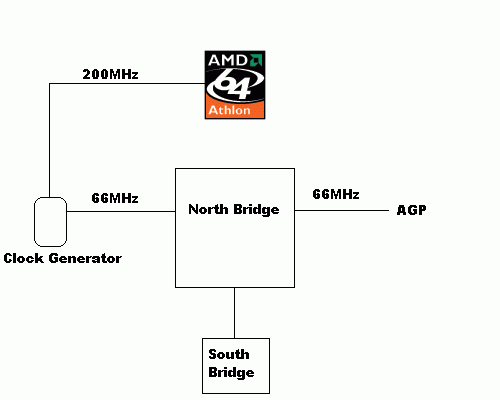
The external clock generator actually produces two clock signals: a 200MHz and a 66MHz signal. The 200MHz signal is used for the initial handshake with the CPU, but the actual running HT frequency is derived from the 66MHz clock input to the North Bridge. The K8T800 PRO North Bridge has an internal clock generator that takes the 66MHz input clock and produces a 200MHz clock, which it then feeds to the Hyper Transport interface within the chip (which in turn sets the CPU clock frequency).
The AGP frequency in this case is also derived from the 66MHz input clock, as is the PCI frequency. When you increase the HT frequency of your K8T800 PRO motherboard operating in synchronous mode, the 66MHz clock is actually what's being adjusted, and thus, all of the clocks including the AGP and PCI clocks are adjusted as well. Obviously for overclocking, this isn't desirable, since the max attainable overclock is now limited by how high your AGP and PCI devices can be overclocked. To put it in perspective, in synchronous mode, most systems will be limited to a 219MHz Hyper Transport overclock, while a working asynchronous mode (AGP/PCI lock) can allow overclocks of close to 280MHz (see nForce3 250 overclocking tests).
One feature of the K8T800 PRO is its support for asynchronous operation through the use of an AGP/PCI lock. The diagram below describes what happens in asynchronous mode:
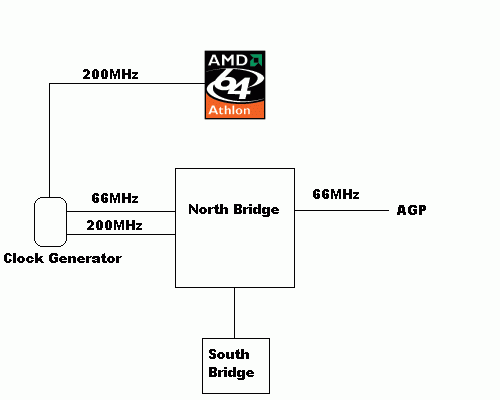
Here, you see that a second 200MHz clock is generated externally and also fed into the North Bridge. This 200MHz clock is used solely for the Hyper Transport interface, while the 66MHz clock remains present to drive the AGP and PCI interfaces. Thus, when you increase your HT frequency in asynchronous mode, only the 200MHz clock is touched, while the 66MHz clock remains constant.
So, why is it that VIA's AGP/PCI lock doesn't work all the time? Architecturally, from a high level, everything seems fine. But as simple as our explanation here may be, actually implementing a multi-clock environment is quite difficult. Designs like this require very complicated clock trees that ensure all parts of the chipset receive the same clock signal at the same time. Introducing a second clock to some of the components complicates things even more, as you now have multiple clock trees to deal with and the components running off of different clocks still need to communicate with one another as fast as possible.
Without having low level access to the chipset, your guess is as good as ours as to what's wrong with VIA's AGP/PCI lock. VIA just recently started working on the problem and is searching for a solution, but without even knowing the solution themselves, it's hard to tell whether it can be fixed via a BIOS update or if it will require another revision of the chipset.
Socket 939: Motherboard Features
The best way to compare features of the 939 chipsets is to compare them in our reviews at:VIA K8T800 PRO: PCI/AGP Lock and 1000 HyperTransport for Athlon 64
nForce3-250 - Part 2: Taking Athlon 64 to the Next Level
nForce3-250 - Part 1: Taking Athlon 64 to the Next Level
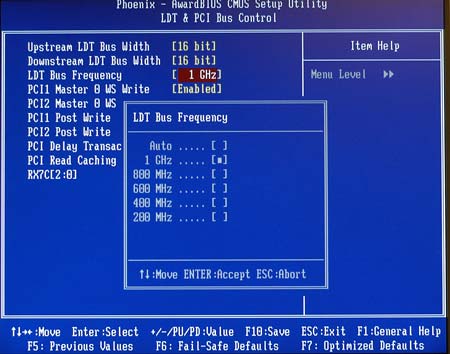
Several motherboards were available at the launch of 939, including the Socket 939 Reference Boards from both VIA and nVidia. At the very last minute, two new boards showed up, both manufactured by MSI, and both very close to final production products for MSI. Since we were interested in comparing the performance of nVidia and VIA on Socket 939 processors, these two MSI boards made the perfect test platform.
Basic Features: nVidia nForce3-250Gb Reference Board
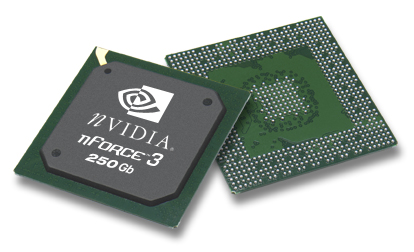
| nVidia nForce-250Gb Ultra Motherboard Specifications for 939 MSI MS-7025 (K8N Neo2) |
|
| CPU Interface | Socket 939 Athlon 64 and Athlon 64 FX |
| Chipset | nForce3-250GB single-chip |
| Bus Speeds | 200MHz to 300MHz (in 1MHz increments) |
| PCI/AGP Speeds | Synchronous or Asynchronous PCI/AGP Fixed at 66/33 to 100/50 (in 1MHz increments) |
| CPU Ratios | 4 to Default Ratio in 1X increments |
| Core Voltage | Default to 1.81V in % increments (with 1.50V, 1.57V, 1.60V, 1.65V, 1.68V, 1.73V, 1.76V, 1.81V) |
| HyperTransport Frequency | 1000MHz (1GHz), 1X-5X |
| HyperTransport Width | 16-bit Upstream and 16-bit Downstream |
| DRAM Voltage | Auto, 2.5V to 2.85V in 0.05V increments |
| AGP Voltage | 1.5V-1.85V in 0.05V increments |
| AUTO Overclock | D.O.T. Ranger, 1%, 3%, 5%, 7%, 9%, 11% |
| Memory Slots | Four 184-pin DDR DIMM Slots Dual-Channel Configuration Regular Unbuffered Memory to 4GB Total |
| Expansion Slots | 1 AGP 8X Slot 5 PCI Slots |
| Onboard SATA/IDE RAID | nVidia 4-Drive SATA Plus 4-Drive IDE IDE/SATA can be combined in 0, 1, 0+1 |
| Onboard IDE | Two Standard nVidia ATA133/100/66 (4 drives) |
| Onboard USB 2.0/IEEE-1394 | USB 2.0 ports supported by nF3-250 2 1394A FireWire ports by VIA VT6306 |
| Onboard LAN | 1Gigabit Ethernet on-chip by nF3-250GB |
| Onboard Audio | Realtek ALC850 8-Channel with UAJ |
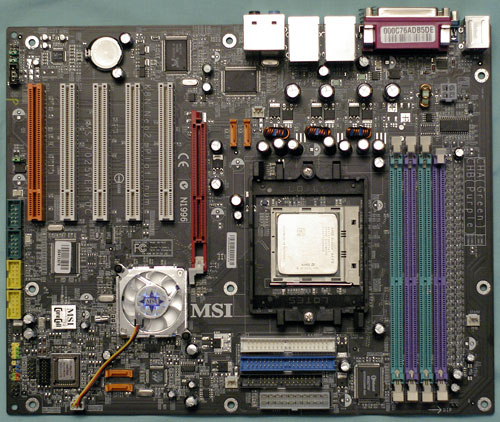
Basic Features: VIA K8T800 PRO Reference Board
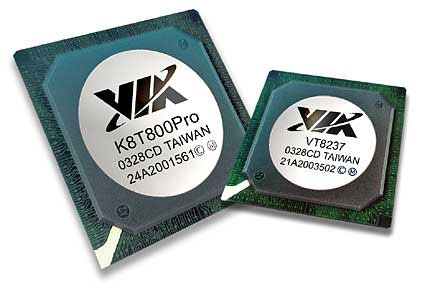
| VIA K8T800 PRO Motherboard Specifications for 939 MSI MS-6702E (K8T Neo2) |
|
| CPU Interface | Socket 939 Athlon 64 and Athlon 64 FX |
| Chipset | VIA K8T800 PRO/VIA VT8237 |
| CPU Ratios | None |
| HyperTransport | Auto, 1Ghz, 800MHz, 600MHz, 400MHz, 200MHz |
| Bus Speeds | 200MHz to 250MHz (in 1MHz increments) |
| PCI/AGP Speeds | Automatic, Async at 66.8 or 75.4 |
| Core Voltage | No Adjustments |
| DRAM Voltage | No Adjustments |
| AGP Voltage | No Adjustments |
| Memory Slots | Four 184-pin DDR DIMM Slots Dual-Channel Configuration Regular Unbuffered Memory to 4GB Total |
| Expansion Slots | 1 AGP 8X Slot 5 PCI Slots |
| Onboard Serial ATA RAID | VIA 8237 (2 Drives, 0, 1) |
| Onboard IDE | Two Standard VIA ATA133/100/66 (4 drives) |
| Onboard USB 2.0/IEEE-1394 | 8 USB 2.0 ports supported by 8237 No Firewire |
| Onboard LAN | VIA VT6122 Gigabit LAN |
| Onboard Audio | VIA VT1616 codec AC '97 2.3 6-Channel with UAJ |
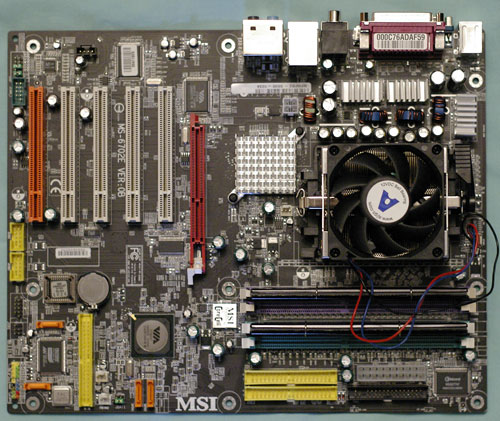
While both Reference Boards were manufactured by MSI, it is important to note that they were different from each other in some important ways. The VIA-based 6702E was a special board produced by MSI for AMD - mostly for review and qualification of the Athlon 64 Socket 939 CPU. While this K8T800 PRO board is based on the upcoming MSI K8T Neo2, it is missing the voltage controls and adjustments that are included on production boards. By contrast, the nVidia-based 7025 was an all but finished production version of the K8N Neo2 Platinum, with all of the ratio and voltage adjustments that you will see on the shipping K8N Neo2. We were assured that the performance of both boards was close to what will be found on production Neo2 boards for Socket 939, but you will still likely see some changes in adjustments and performance on the final shipping motherboards from MSI. Still, the opportunity to do a direct comparison of Socket 939 boards from the same manufacturer was too good to pass up.
Performance Test Configuration: Chipset Comparison
| Performance Test Configuration | |
| Processor(s): | Athlon 64 FX53 Socket 939 (2.4GHz, 1MB Cache) Athlon 64 FX51 |
| RAM: | 2 x 512MB Mushkin PC3500 Level II OR 2 x 512MB OCZ PC3500 Platinum Ltd |
| Memory Timings: | 2-2-2-10 Command Rate 1T "Aggressive"" memory setting |
| Hard Drive(s): | Seagate 120GB 7200RPM SATA (8Mb buffer) |
| Video AGP & IDE Bus Master Drivers: | VIA 4in1 Hyperion 4.51 NVIDIA nForce Platform Driver 4.15 |
| Video Card(s): | ATI Radeon 9800 PRO 128MB (AGP 8X) |
| Video Drivers: | ATI Catalyst 4.5 |
| Operating System(s): | Windows XP Professional SP1 |
| Motherboards: | AMD Reference Board MSI MS-6702E (K8T Neo2) nVidia MSI MS-7025 (K8N Neo2) |
Benchmarks used either Mushkin PC3500 Level II or OCZ PC3500 Platinum Ltd memory modules. Both DIMMs use Winbond BH5 chips and perform virtually the same in our tests.
All performance tests were run with the ATI 9800 PRO 128MB video card with AGP Aperture set to 128MB with Fast Write enabled. Resolution in all benchmarks is 1024x768x32 unless otherwise noted. While we do have an ATI X800 PRO in the lab, all testing used our standard video test configuration with the ATI 9800 PRO 128MB. This allows the best comparison of test results to CPU tests in our Socket 939 launch review and earlier motherboard benchmarks. AnandTech will update the video card test standard to one of the new generation video cards as soon as the new cards are widely available in the market. We have not yet determined our new video test standard as we have not yet tested shipping retail cards from either nVidia or ATI.
Memory Timings
Prior to benchmarking, a complete series of memory bandwidth tests were run on the Socket 939 motherboards using memtest86. We found the fastest memory timings for both the nForce3-250 and K8T800 PRO to be 2-2-2-10. tRas timings produced about the same bandwidth at any setting in the 9 to 11 range on both test motherboards, but memory bandwidth decreased slightly below a tRas setting of 9 and above a tRas setting of 11. In the tests of performance of tRas settings from 5 to 15, the worst performance in the range was at tRas 5. On the Intel platform, best performance is generally achieved at the fastest timings, but tRas 10 was fastest on Athlon 64 platforms. The memory bandwidth improvement at tRas 10 was only 2% to 4% over tRas 5 and 6 depending on the speed, but the performance advantage was consistent across all tests. Since best performance was achieved at 2-2-2-10 timings, all Athlon 64 benchmarks were run at a tRas setting of 10.The Importance of Command Rate
Socket 754 Single-Channel motherboards performed best with a memory Command Rate setting of 1T in BIOS, but that generally was a stable option with only one DIMM. 2 or more DIMMs normally required a 2T Command Rate setting for most stable performance. There was a performance increase at the 1T Command Rate setting, but the real performance increase was very small.Socket 939 Dual-Channel motherboards were found to exhibit a very wide performance difference between a Command Rate setting of 1T and a setting of 2T. The impact on memory bandwidth is dramatic between these 2 settings. In SiSoft Sandra 2004 standard buffered Memory Benchmarks, a 1T command rate showed a Sandra bandwidth of 6000 Mb/sec, while a 2T rate with the same 2 DIMMs in Dual-Channel mode was only 4800 Mb/sec. This is a huge difference in memory bandwidth and the Command Rate setting definitely impacts performance test results on Socket 939 motherboards. All AnandTech benchmarks were run at a Command Rate setting of 1T. This includes all benchmarks that were run in the CPU tests, as all benchmarks were rerun in the CPU tests as soon as we had verified the performance impact of Command Rate settings.
General Performance and Encoding
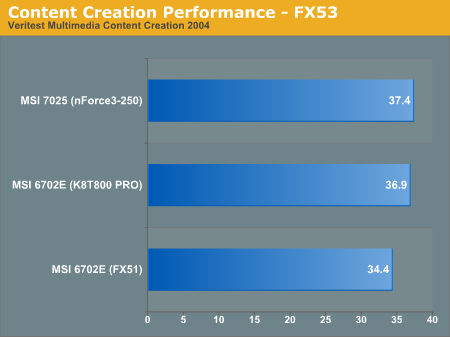
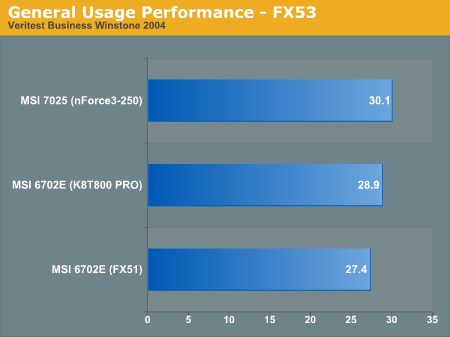
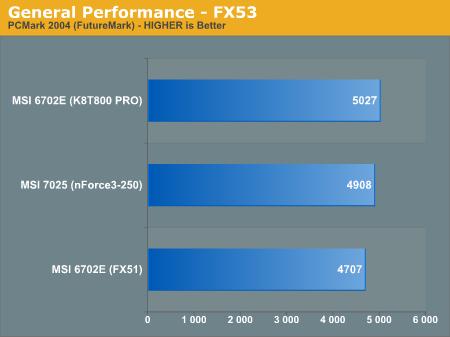
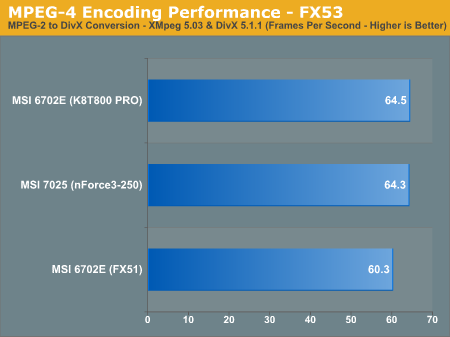
We really expected our suite of General Performance benchmarks to be a dead heat, but the performance of the chipsets, while close overall, were surprisingly different depending on the benchmark.
The nVidia nForce3-250 Ultra performed best on Business Winstone 2004, outperforming the VIA board by over 4%. nF3-250 was also a slightly better performer in Multimedia Content Creation. Change the benchmark to PCMark 2004 and the VIA K8T800 PRO is the better performer by about 1% to 1.5%. The 4% difference in Business Winstone 2004 is wider than we would expect to see when the only variation is chipset, and we do not have an explanation for this performance variation.
Two-Pass media encoding was about the same for both chipsets.
Gaming Performance
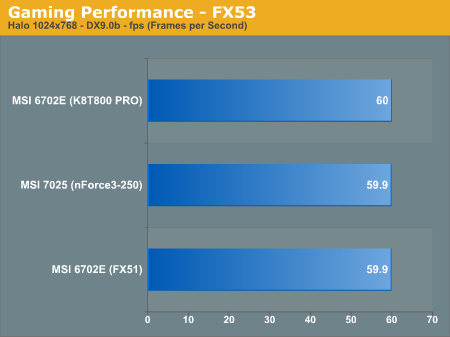
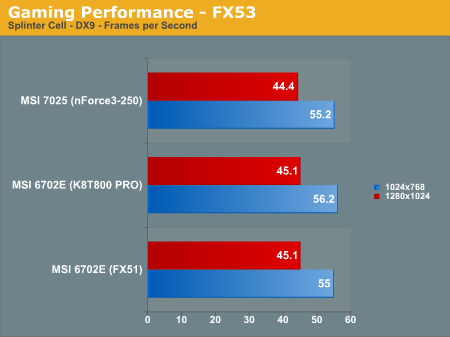
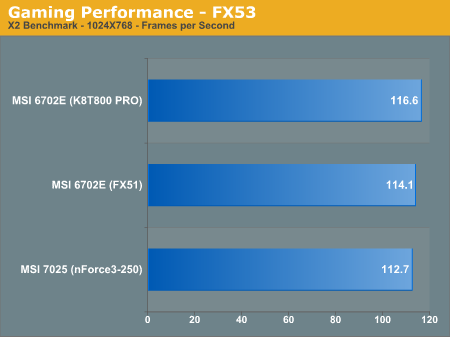
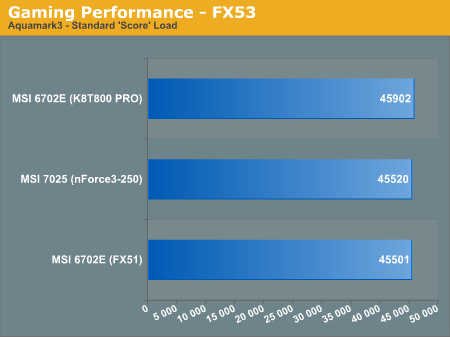
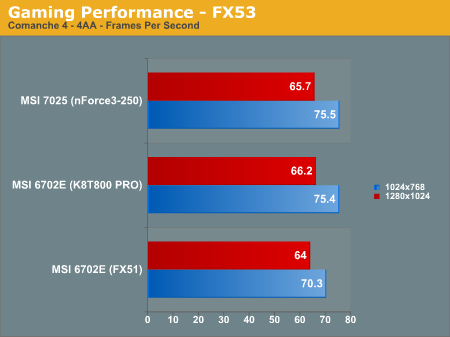
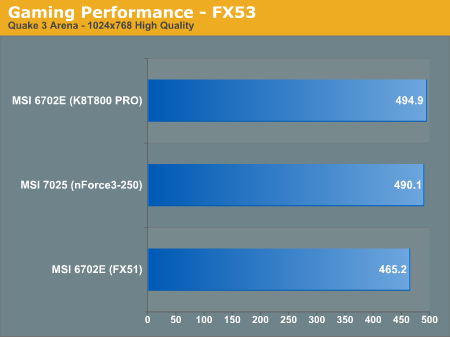
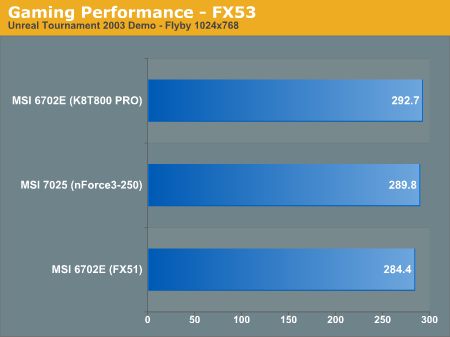
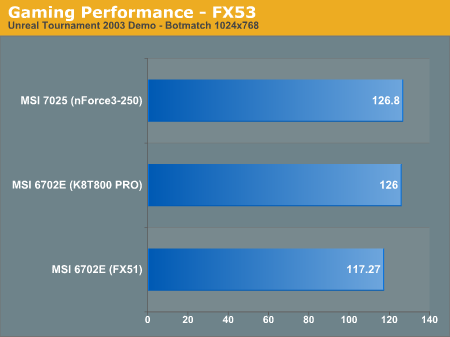
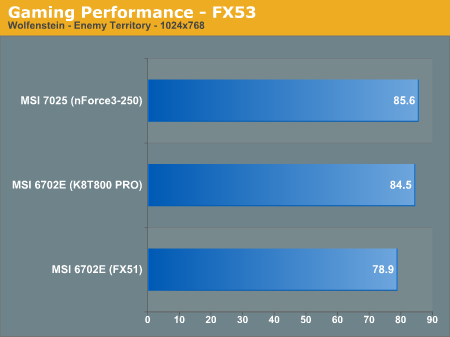
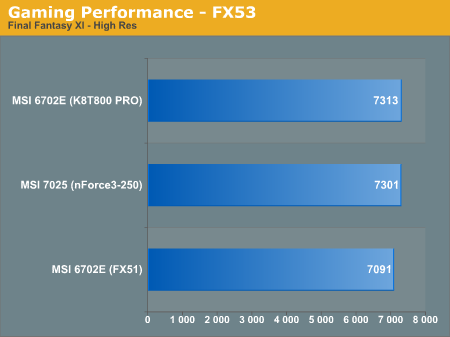
Halo and Splinter Cell are both Direct X 9 games and they are very useful for testing video performance. However, we are finding in many months of benchmarking that Halo and Splinter Cell are not very useful as motherboard/system benchmark tests. As you can see in our results, both tests produce similar results across our tests. Even the FX51 test results are almost the same as those with the faster FX53. For these reasons, Halo and Splinter Cell will be dropped as a standard benchmark for future motherboard and system testing.
The K8T800 PRO and nForce3-250 Ultra are close in gaming performance, but the VIA chipset is generally a slightly better performer. The exceptions are the excellent Return to Castle Wolfenstein - Enemy Territory, where the F3-250 takes the lead, and Comanche 4, where the chipsets switch the lead depending on resolution. Overall, we would consider the gaming performance so close that you would never notice any performance differences in the 2 chipsets. Both are excellent gaming performers.
Workstation Performance
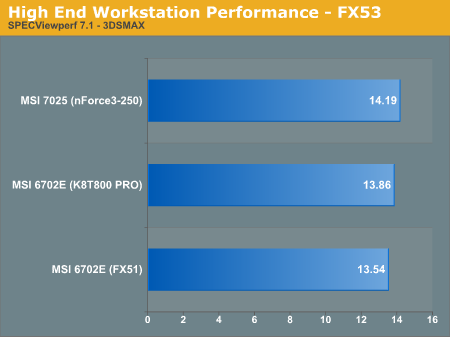
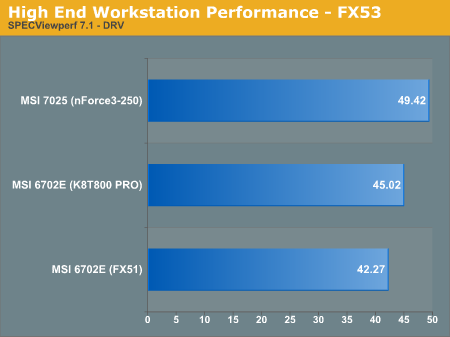
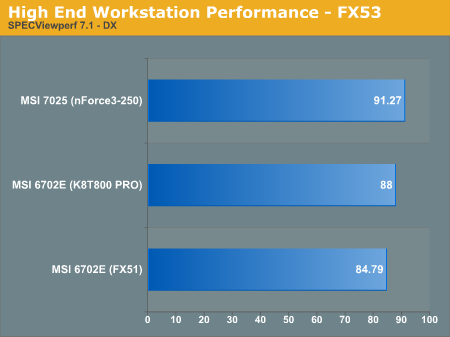
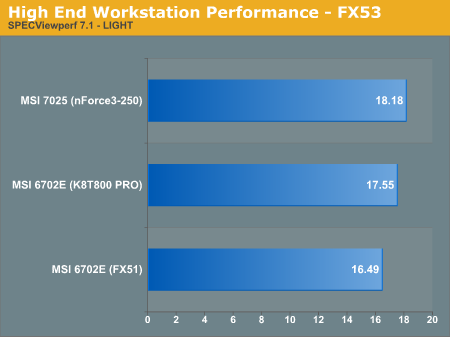
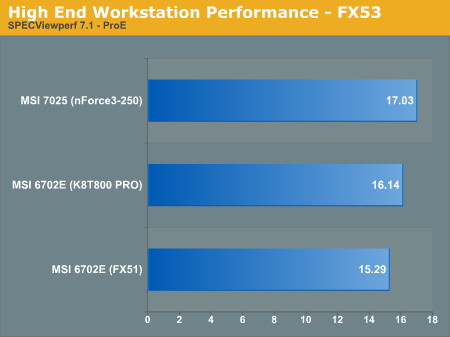
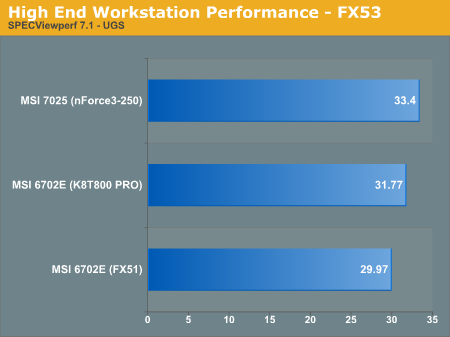
nVidia's experience as a producer of Workstation Graphics cards shows in Workstation Performance results. Across the board, the nVidia nForce3-250 Ultra is the clear winner over VIA in Workstation Performance. The performance lead is often surprisingly wide for nVidia in Workstation benchmarks, especially considering the chipsets are running the same memory controller on the same FX53 CPU at the same speed.
While we have seen this performance pattern in SPECviewperf before, the nVidia performance lead in this area is wide enough that we would definitely recommend nForce3-250 Ultra over K8T800 PRO for workstation graphics.
Final Words
The last time we compared Dual-Channel chipsets on Athlon 64 was in our Socket 940 roundup. At that time, nVidia was hampered by a 600 Hyper Transport bus on their nForce3-150 cipset and VIA emerged as the clear winner. Things have changed quite a lot since that 940 comparison, particularly for nVidia. Both chipsets now sport the same 1000 HyperTransport that is specified for the new Socket 939. nVidia has also added many cutting edge features, such as on-chip Gigabit LAN and a unique on-chip Firewall. nVidia also has added up-to-date features to nF3-250, so the chipset now compares very well to the best chipsets in the market, and they also fixed one of the trademark nVidia features - the AGP/PCI lock (or asynchronous operation). As we saw in our recent Socket 754 roundup, the AGP/PCI lock not only worked on every nForce3-250 motherboard that we tested, but this feature proved to allow some of the highest overclocks that we have yet achieved on Athlon 64.VIA, on the other hand, has done little to improve on the K8T800 PRO chipset in the past year. The PRO version adds 1000 HyperTransport and claims to have added VIA's first working PCI/AGP lock to the K8T800 PRO features. VIA would point out, and we would agree, that the K8T800 was already a superior chipset and that a long list of improvements were not needed as they were on nVidia's first nF3-150 chipset. However, nVidia's nForce3-250 Ultra is a stiff competitor in the latest round of Athlon 64 chipset updates and as a result, VIA needed to bring all the features that they could to the table for this round.
While we are here at Computex, we have been able to talk with many manufacturers about the PCI/AGP locks on the VIA K8T800 PRO and the nVidia nForce3-250. We have also talked with VIA. Right now, the PCI/AGP lock works on every nForce3-250 chipset that we have tested, while it works on some VIA K8T800 PRO chipsets, but does not work on others. It appears from the information we have right now that the VIA PCI/AGP lock is not a reliable or consistent feature on the K8T800 PRO chipset. Since this is an important feature to many Enthusiasts, who are a large percentage of readers at AnandTech, our advice FOR NOW is to buy an nForce3-250 chipset if the PCI/AGP lock is an important feature in your Athlon 64 purchase decision.
As you clearly saw in our performance tests of the K8T800 PRO and nVidia nForce3-250, the performance is very close between the two chipsets on the Dual-Channel Socket 939. VIA is slightly faster on many of the standard gaming benchmarks, while nVidia is the better performer in Workstation Graphics. The chipsets trade wins in our General Performance and benchmarking tests. If everything else were equal, we would have concluded that the battle is a toss-up, and you should choose either chipset for 939 based on features that were important to you. For absolute best performance, we would say VIA is slightly faster in general, but nVidia is clearly the better performer in Workstation graphics.
However, the PCI/AGP lock confusion has to enter into our recommendations. If the PCI/AGP lock is not an important feature and you do not plan to overclock, then you can safely choose either the VIA K8T800 PRO or the nVidia nForce3-250 Ultra chipset for your new Athlon 64 motherboard. In fact, if you do not plan to overclock at all, the VIA K8T800 PRO is slightly faster than nForce3-250, though the difference is so small that it is of no real consequence. However, if a working PCI/AGP lock is important to your buying decision or you intend to more than mildly overclock the Athlon 64, you should buy an nVidia nForce3-250 Ultra motherboard. Until VIA can fix the teething problems with their new PCI/AGP lock feature for Athlon 64, we cannot recommend the K8T800 PRO for those buyers looking for the PCI/AGP lock feature. This will likely be corrected in the future and we will take another look at VIA asynchronous capabilities as soon as we can verify that this is a consistent and reliable feature on the K8T800 boards.







